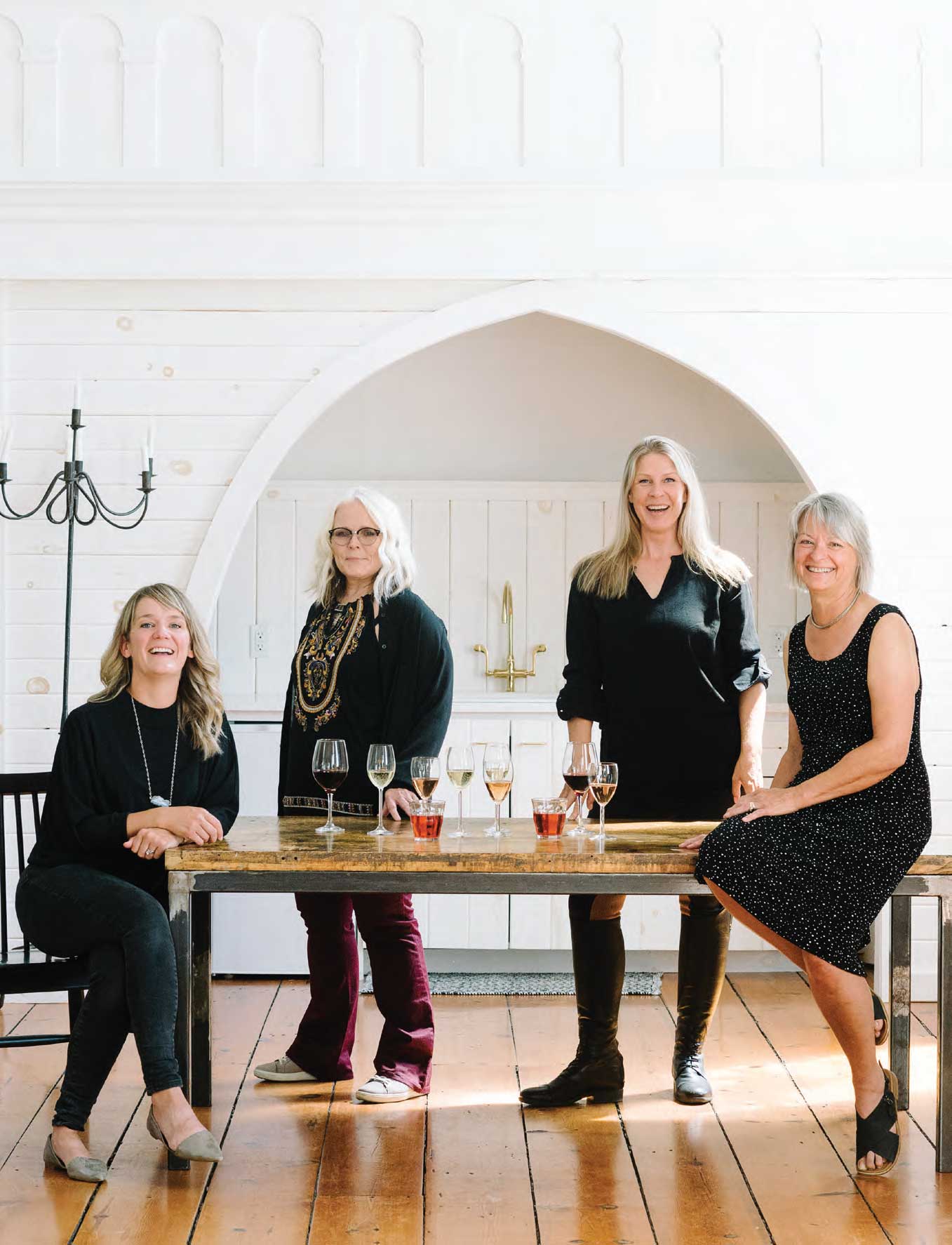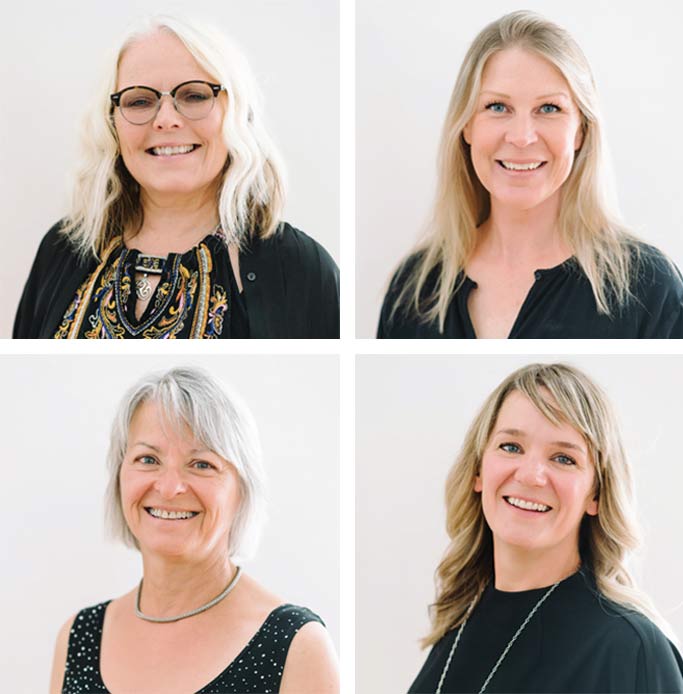
Our panel of experts sharing insights and camaraderie along with wine and cider. From left: Sara Boyd, Astrid Young, Marlise Ponzo, Bev Carnahan.

Clockwise from top left: Astrid Young, Marlise Ponzo, Sara Boyd, Bev Carnahan
Four women, all professionals embedded in the Prince Edward County wine and hospitality scene, come together to discuss wine, women and even song in the 21st century.
In days long past, the threefold prescription for a hedonistic life was “wine, women and song,” a possible precursor to the more raucous and less gender-specific “sex, drugs and rock ‘n’ roll.” But this tenet prevailed, and for centuries a woman’s perceived relationship to wine was as an equal – both of them serving as instruments of pleasure.
There’s been much water under the bridge since then, but as recently as 30 years ago, it was still uncommon for women to establish themselves with any real clout in the male-dominated hospitality and beverage industries. Although the wine scene was occasionally punctuated with powerful female figures, it’s only over the last decade that the field’s stats have come up for female winemakers, writers, agents, teachers and students; and in many areas, representation is still sparse. Of the 172 Master Sommeliers in North and South America combined, only 28 are women.
In Prince Edward County, as women edge into roles from entry to executive, we embrace their talent. So we saluted the Stage 2 partial easing of COVID-19 protocols by sitting down with four industry women to talk about carving out niches, establishing a work-life vision, rolling with the unexpected (like a global pandemic), and what makes it all worth it.
Astrid Young, The Rock Somm
Wine Director at Merrill House
Astrid is a bit of a legend, if you will. A powerhouse woman who’s lived at least three regular people’s lives to the fullest, she has a few platinum albums under her belt, a bestselling novel, and has partied with some of the greatest rock stars of all time. Oh, and she’s also a force in the world of wine, having travelled far and wide with some of the globe’s best bottles. Joining Merrill House in 2018 as Wine Director, Astrid cultivated a cellar that has just earned its second Wine Spectator’s coveted Award of Excellence for 2020.
Marlise Ponzo, The Mom Somm
Sales & Events Manager at Grange of Prince Edward Estate Vineyards & Winery
Marlise’s 20-year career in hospitality began at Crush Wine Bar. Acquiring Sommelier certification, she went on to teach and write on wine, found “Crushing on Wine Sommelier Services” and work in the industry. Joining The Grange’s winery team in early 2019, her extraordinary organizational skills allowed for masterful juggling of the full-time position, while raising three busy children, several horses, a giant Daniff pup, and a plethora of farm animals, cats, and bees – alongside her husband, Chef Albert Ponzo.
Bev Carnahan, The Boss Somm
Director at the All Canadian Wine Championships
With three decades of restaurant industry experience, Bev took over the ACWCs in 2003 – a wine competition with the noble cause of creating visibility and credibility for excellent Canadian wines. She has a true love and respect for the Canadian wine industry and is the vibrant force behind the competition, an event that corrals a talented and diverse team of Canadian judges and sets them up behind tens of hundreds of bottles, from the Annapolis Valley to Prince Edward County.
Sara Boyd, The Pomm
Owner and Cidermaker at Loch Mór Cider Co
Sara is one of only three pommeliers in all of Canada. Educated in Montreal, Sara worked and lived abroad, then met, married and had kids with her husband in the UK. Neither worked in the alcoholic beverage industry, but travelled extensively to old-world cidermaking regions in the UK, France and Spain before moving to San Antonio, Texas and discovering that the kind of cider they liked to drink wasn’t available. Realizing that this cider required specific types of apples, they researched prime apple-growing regions, and, in the spr in g of 2017, planted an o rchard in Hillier and launched Loch Mór Cider.
ON GETTING INTO THE INDUSTRY…
ASTRID YOUNG: Well, I was living in Los Angeles in the 80s and 90s, working with an orchestra contractor and trying hard to get into film music and composing. A group of us from a big studio’s music department went to lunch one day and were talking about how much we hated dealing with the “suits” in the film industry. One guy said, “You just have to play golf or know about wine and you’ll always have something to talk about with them.” I went out the next day and bought a copy of Wine Spectator and read it cover to cover… It all snowballed from there.
MARLISE PONZO: Albert and I used to work hard and play hard. We would travel, dine, and venture off the beaten path on the most interesting culinary journeys. I remember one trip to Spain where we flew into San Sebastián, threw our bags into the hotel and went for dinner at Michelin star restaurant Arzak… then flew out again the next morning. The more I travelled, saw where the wine was being made, and tasted the cuisine of the areas, the more I fell head over heels in love.
BEV CARNAHAN: I’d been in the restaurant industry from age 25, working my way from a simple Greek pizza place to progressively finer establishments. It was part of the service to be able to navigate the wine list and help our guests pair food with the appropriate wines. When we moved to Windsor and I had taken over the All Canadians, becoming a somm was a natural step to understanding the analytical nature of wine judging.
SARA BOYD: For me, becoming a pommelier is really about educating consumers and the trade. As hard ciders are made in drier styles – with more traditional methods and from apples that actually exhibit traits of the terroir – they’ve begun to pop up on restaurant wine lists and are bringing cider to a new level.
“There is something so astonishingly savoury, saline, bright, chalky and extraordinary in the wines of this region. They are food friendly and have depth and complexity.”
MARLISE PONZO
ON FEMALE INDUSTRY INFLUENCES…
ASTRID: I came in on the back end of the “Michael Broadbent era” [referencing the decades-long approach to wine by quintessentially stodgy, conservative wine guides written by men]. Wine was starting to be cool, but was still largely seen as an “old man’s fancy.” It was mostly men on the somm side of things, but the women who were in it were formidable, passionate and, in my opinion, better tasters and more open-minded in general.
MARLISE: I had a fabulous group of fellow somm students that formed a Sunday morning study group at Crush. Among them were Erin Henderson of The Wine Sisters and Trisha Molokach of I4C. I crazy love those girls and their love and support went a long way in the high-pressure wine learning and certification process.
BEV: While men have dominated the wine industry in many segments, judging is a natural fit for women. There are many studies that suggest women could have a more acute palate. Tasting professionally takes discipline, whichever gender. But I’d like to see my panel evolve into a more even balance of the sexes. The men have had command of this platform long enough – it’s time to share it.
ON PRINCE EDWARD COUNTY…
ASTRID: When I first came to the county in 2002, there was little you could see, but there was an underlying current of excitement about the future. The 2007 vintage was the turning point. Everybody had a great vintage and suddenly there was some evidence as to what was possible here.
MARLISE: These days, we drink local more often than not. There is something so astonishingly savoury, saline, bright, chalky and extraordinary in the wines of this region. They are food friendly and have depth and complexity. We have always been drawn to them, drawn to this area – it is honestly like a beautiful dream to wake up here on the farm every morning.
BEV: We were visiting the County when there were fewer than ten operating wineries. In 2004 we started thinking that this was going to be high on a very short list of possible retirement locations. The area we came from, Lake Erie north shore, was more established and had the climate and conditions to make bigger reds, but PEC had an entrepreneurial spirit and we wanted to be part of that.
SARA: We are becoming one of the up-and-coming areas for cider in Ontario and Canada. There’s a lot of interest in the potential for single varietal ciders, linked to the terroir. A Northern Spy apple will taste different between orchards in the County, let alone farther afield. As more cider-specific orchards come into full production across the province and country, it’ll be interesting to see the difference between a Dabinett single variety in PEC, versus Okanagan, versus the Finger Lakes region, just across the lake.
“I think the companies that will rise to the top will be the ones that adopt a start-up mentality – because you’re really going to have to do a lot of out-of-the-box thinking to make it work.”
ASTRID YOUNG
ON WORK-LIFE BALANCE…
MARLISE: In 2009, I struggled with the idea of going back into restaurant life. My husband being a chef meant neither parent would be there in the evenings for baths, books and bedtime snuggles with the kids. I now enjoy a shortened day, Monday to Friday, and I love dropping off my three kids in the morning at school, picking them up and checking in on the drive home. The work I have to fit into those hours is by no means reduced – being a working mom means being organized, working smarter and harder and getting stuff done quickly and accurately.
SARA: It’s hard to juggle everything – mother, partner, cidery – especially whilst [recently] homeschooling the three kids. We set out the insect traps in early summer and I’ve been teaching them about the different insects in the orchard. They do help with bottling, but their favourite is picking apples in the fall. I hope that we’re teaching them the value of hard work and putting effort into producing a quality craft product using ingredients you’ve grown yourselves.
ON COVID-19 AND THE FUTURE…
BEV: The online purchases are through the roof. Many have given more attention to their website in that regard, with more news, free delivery, curbside pickup, et cetera – it’s a good thing, and I can see it shifting how people make their wine purchases in future: pivot and adapt!
MARLISE: My vision for the future of the wine industry is bright. Wine and wine tourism, as industries are growing fast, and people are more interested than ever in the story behind the product. I think that change in the industry will continue – winemakers acting as ambassadors of the land – and the future will be all the more beautiful because of it.
SARA: COVID has been hard. It has been hard for cideries, who haven’t been able to open fully, or at all. It has been hard to pivot to online sales when consumers haven’t tasted your product before. It has been hard for growers, who haven’t been able to find the workers to prune, plant, train and then harvest the fruit.
ASTRID: I think everyone’s hoping things will go back to the way they were, but I don’t see that happening. [Fine dining] has slim margins and a precarious business model as it is, but when you face a significant reduction in volume and revenue, you either have to raise prices or reduce food costs, which means sacrificing either value or quality. Ultimately, each venue will have to decide what makes the most sense for them, but many won’t survive. Another problem is that as the demand picks up, it’s really hard to say “no,” but you have to draw the line somewhere, and I think the organizations that prioritize safety over profits are going to thrive. I also think the companies that will rise to the top will be the ones that adopt a start-up mentality – because you’re really going to have to do a lot of out-of-thebox thinking to make it work. Anybody who continues to hold onto a pre-COVID fantasy might as well close up shop right now. It’s never going to be that way again.
ON MOTIVATING MOMENTS…
SARA: For me it was Burrow Hill Cider Bus at Glastonbury Festival. Amazing music festival, great cider made down the road by Julien Temperley at Burrow Hill/Somerset Cider Brandy. I went in 2007 – the headliner was The Who. It was a really muddy year (the rain made a river underneath our tent), and to get to the cider bus, you had to wade through mud up to your mid-calf. I bought my yellow Hunter rubber boots for the festival and I still wear them in the orchard now.
MARLISE: I am constantly moved by wine. It’s hard to pinpoint any one time in particular. I suppose I am lucky to have enjoyed so many extraordinary tasting experiences. I have been moved by a rare Burgundy or beautifully aged Barolo, but also had my soul stirred by house wine from roadside farms in the south of Italy, taken away in jugs and shared on a beach.
ASTRID: It all came into sharp focus for me one evening. I was at a birthday party for someone, maybe Sting, I can’t remember. Anyway, it was at A&M Studios, Studio A (the one where they did “We Are the World”), and Phil Spector is there, the Rolling Stones, Richard Lewis – I guess whoever was recording in the studio at the time. I got into a conversation about wine with some folks and the next thing I knew, there was a group of people around me and we’ve got a lively discussion going… and over there in the far corner, sitting on a couch all by himself, was Mick Jagger.
Perhaps Astrid’s story illustrates the “song” part of the “wine and women” equation, music momentarily overlooked as the variables shifted, but considering that women have moved from being one of the consumables in this iconic trifecta, to consumers, creators and conduits – we’ve demonstrably come a long way. Along with our sensibilities about what constitutes gender-specific interests, consumer habits have evolved. Canadian women have leapt up in numbers as the biggest users and purchasers of wine, and the industry representation reflects that, as women emerge from behind-the-scenes roles to front-of-house principals. All around us, borders are changing, lines are shifting, perceptions are broadening (and contracting) and a horizon of hazy frontiers awaits our focus. As more and more industries move to take their workforces online, the very immediate and real experience of sitting around an old wooden table with four very talented women, to share the unique challenges and chances that led them all to this moment in time, is both the flame and spark of revolution.
Story by:
Lonelle Selbo
Photography by:
Tara McMullen

